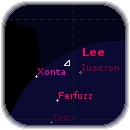 Table of contents
<< previous page
next page >>
Table of contents
<< previous page
next page >>
4. Navigation If you click on the "Navigation" link in the main menu, a map of the known regions of Kosmor's galaxy is displayed.
If you click on the "Navigation" link in the main menu, a map of the known regions of Kosmor's galaxy is displayed.
Set waypoint: Use this command to order your warplanet to any point in space. To do this, click on any object (or even open space) on the map, then confirm the command by clicking on "set waypoint". Your warplanet will move towards the given target. Solar systems have small star icons, the names are on the upper right of these symbols. Note: If you want to set course to a solar system, make sure, that you exactly click on the star icon in the navigation map. If the solar systems' name, type and owner are displayed, you have correctly selected it. You should now "set waypoint" to confirm this course.Solar systems with larger base planets (more possible inhabitants and mines) are displayed brighter on the map. It is possible, that names of "darker" (or smaller) stars are overwritten by other solar system names. That is quite normal. To get more information about a star's name or size, just click on its star symbol once (and do not set course afterwards). If solar systems are displayed in other colors than grey or white, they are already occupied by other imperators and aren't neutral anymore. (Note: to occupy a neutral solar system, it is sufficient to install some of your house members on that star. To conquer an enemy solar system, you should at least have one warship in orbit of your warplanet - or you will lose that battle!) You can access a few navigation tools in the upper frame of the navigation window:
Color coding on the starmap
Warplanets are depicted by a small cross, the name of the imperator is printed next to it.
The high power engines of warplanets cause small structural fluctuations in space. They are
depicted as small grey lines. These lines show the last movement vector of the warplanets and allow a quick overview of last turn's movement.
Range of your scanners: Every object under your direct control has a blue radar circle around it. The solar systems of subordinates have dark grey radar circles around them. Every object within your or your subordinates' radar range is displayed on the map. To get information about an object within radar range, just click on the object. In the right frame, the following details may be displayed:
If have set course (to any object or "deep space"), a yellow navigation line will be plotted. It simply visualizes your travel route. In the upper right part of the screen, a mini-map window is drawn. It shows an overview of your empire. This window is clickable and can save a lot of time when navigating in a larger empire. Tip: Your warplanet has a daily travel range of 60 lightyears. It can be easily intercepted by enemy warships, so try to protect your warplanet well! Note: If you want to capture a neutral solar system, take care, that you have 33, 66 or 100 (depending on the size of the base planet) house members left on your warplanet. They are necessary to take control of the base planet. Remember: Underlined objects have ships in orbit. |

 Table of contents
<< previous page
next page >>
Table of contents
<< previous page
next page >>